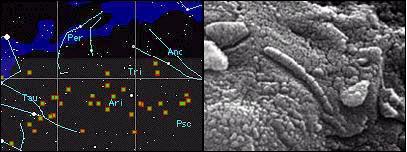The argument of transferring life between planets comes up again * Two theoretical studies from Britain increase the likelihood of the spread of bacteria in the universe

Right: The meteorite from Mars, which may have had life on it. Left: Life can easily spread through the galaxy
Astronomers may have been able to show how microbes from Earth can spread through the galaxy and transport life from place to place. Scientists from Armagh Observatory and Cardiff University say that bacteria can reach space on rocks erupted from planets as a result of a comet or asteroid impact. This is what Dr. David Whitehouse, the scientific editor of the BBC, says. Online.
The calculations show that the bacteria can also leak out of the solar system and scatter other lights. The work was reported in two independent papers published in the Journal of the Royal Astronomical Society. The conclusion of the papers is that life can spread throughout the galaxy and that it may not have originated on our planet.
The study promotes the controversial modern theory - panspermia - the idea that life began somewhere in the universe and arrived on Earth in its youth. Dr. Max Wallis and Prof. Chanarda Wickramasinghe from Cardiff University calculated how fragments from the Earth, thrown into space as a result of a huge impact would integrate into the icy outer layers of comets.
Eventually, after hundreds of millions of years, some of these comets will reach the Kuiper Belt - a region that includes many small worlds made of rock and ice. Because comets sometimes escape from this region into interstellar space, some of them may end up in clouds of gas and dust from which new planetary systems are formed. In these systems, the trapped bacteria can break free and, if the conditions are right, found a lineage of life on the surface of primitive planets.
The two are encouraged by their belief that bacteria can survive such a journey for millions, if not billions of years, due to recent discoveries of bacteria surviving such a period in rocks on Earth. Their detailed calculations hypothesize that anything between a few kilograms and perhaps one ton of microbial-containing materials can move from one solar system to another. According to him, one kilogram of "life-bearing material" is more than enough to seed a new planetary system with life.
In another article in the same month, Bill Napier of the Armagh Observatory in Northern Ireland, writes, offers an alternative way for life to break out of Earth and reach the stars. Rocks that include bacteria and which were blown from the earth as a result of a strong impact of a celestial body, and then also went out of the solar system. According to him, such small rocks can be pushed out of the solar system by the push of sunlight. Because of this, Napier believes that the solar system is surrounded by a "biosphere" that extends from it and is made of rocks that include bacteria that have been preserved within them.
"During the history of the Earth, Napier said, there must have been many cases in which bacteria from Earth were involved in the process of star formation in the clouds of dust and gas in our galactic neighborhood. "When they start, life could have spread throughout the Milky Way on a timescale much shorter than the estimated age of our galaxy - 10 billion years. This means, they claim, that life did not originate on Earth and that it also arrived here from outside.
For information on the BBC website
